My journey to Kaikondrahalli Lake wasn’t just an introduction to the minuscule world of insects and spiders; it was also a technical journey into macro photography. While staying in Bellandur, I had identified this lake as a great reservoir of nature. The first time, I visited for a casual morning walk and I was not prepared for the abundance of life.
Flanked by a busy highway on one side and tall residential towers on the other, Kaikondrahalli Lake thrives even under increasing pressure from urban expansion. Flocks of birds welcome you at the bund, but being uncomfortable with visitors they prefer to leave for a quieter place as you approach them. Kasavanahalli Lake is another treasure trove of biodiversity, and is upstream from Kaikondrahalli (considering the similarities, some parts of this post are from Kasavanahalli as well). The valley zone, the area between these lakes, is technically the buffer between these two interdependent ecosystems. Although it is illegal to carry out construction here, residential complexes have sprung up regardless, putting both the lakes and ultimately the residential area at risk. Considering the global scale of lockdowns faced with the outbreak of infectious diseases due to the abuse of nature, hopefully there would be greater respect for ecosystems and boundaries with our natural world.
Crawl of the wild
I am a sucker for bugs. Bugs of all kinds, all shapes, all sizes, with any number of legs and any number of eyes. It’s the novelty of finding new bugs that keeps me going. The sheer variety of insects in this world is endless for one human to consume. And with photography, finding any bug is rewarding too. With macro photography you see more than you would with the naked eye. It opens the door to these tiny creatures and their amazing details. As you go deeper, the size of the world around you expands and explodes into perspective and opens doors into a wonderful hidden ecosystem.
On my first walk at Kaikondrahalli, I noticed spiderwebs along the rusted railing of the bund. This indicated the presence of these predators in large numbers, which meant the presence of a lot of prey. I looked closer at the plants, bushes, creepers… and the tiny world of these creatures came right within my reach. Everything from moths, lake flies, spiders, dragonflies, bees, ants and butterflies thrived here.
On my next visit, I was well equipped. At this time I was only exploring options for macro photography. I went from using extension tubes, to diopter filters, to renting macro lenses. And since the paradigm of macro photography requires high values of aperture, I also tried multiple lighting solutions with the on-board flash and external speedlight. Soon, I figured I needed to diffuse the light and tried a cheap diffuser, made my own diffuser, and eventually ended up purchasing a professional macro diffuser. But a thought crosses your mind that the quality of images you produce is directly proportional to the amount of money you invest in the equipment. But constantly evolving through different kinds of techniques helps you understand what works best for you and what suits the kind of images you wish to create. Jumping right into getting top-notch equipment would not have helped me, even when I was using makeshift techniques. I thought to myself that if I am putting in all this effort, I might as well go all the way and do it properly. I am glad I did not give in to impulses and continued to learn through experiments and let my approach grow naturally.
It’s all in the eyes
When you start exploring the vegetation around the lake, you observe that certain species exist in a certain habitat, so soon you start identifying these small habitats, and learn to look for them.

These Eristalinus arvorum, commonly called hoverflies, could be easily found hovering about flowering trees or plants. Most species in the genus have distinctive markings on their eyes. Some are banded, while some are dotted like this individual. If I never peeked closer, I would be missing out on all the mesmerising patterns that these tiny creatures carry around with themselves.
Sleeping Dragons
It is always a delight to find dragonflies at rest. If you approach them slowly without making sudden movements, you can even touch their wings. Once that intimacy grows, you have all the liberty to photograph them. But this one time, it was the wings that got my attention — like this dragonfly perched at the end of a dried flower stalk.
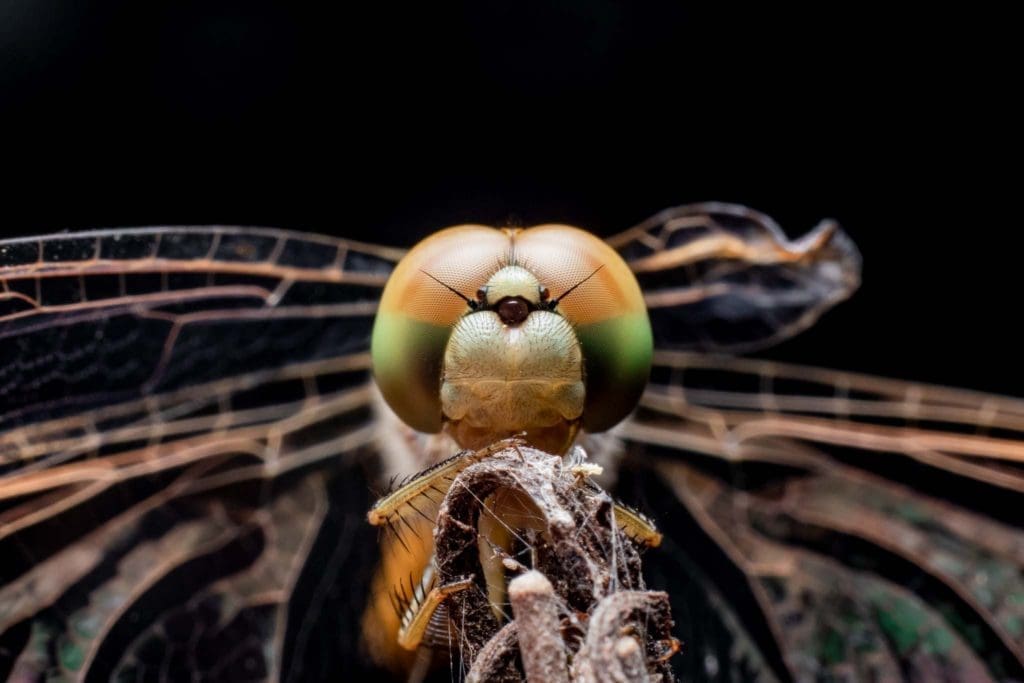
This individual must have lost one wing of its two pairs. Interestingly, it was still able to fly with as much dexterity as any complete individual. But again, what does it even mean to be complete? And then, it dawns upon you that little beings are so resilient.
Disguised to evade death
At first glance, it looks like an ant, and that is the point. Here is a nymph of an Ant-mimic mantis, genus Odontomantis. As juveniles, these praying mantises resemble ants. Mature individuals turn green. This one is starting to develop green legs and the forelimbs are completely concealed and tucked away under the head from this angle.
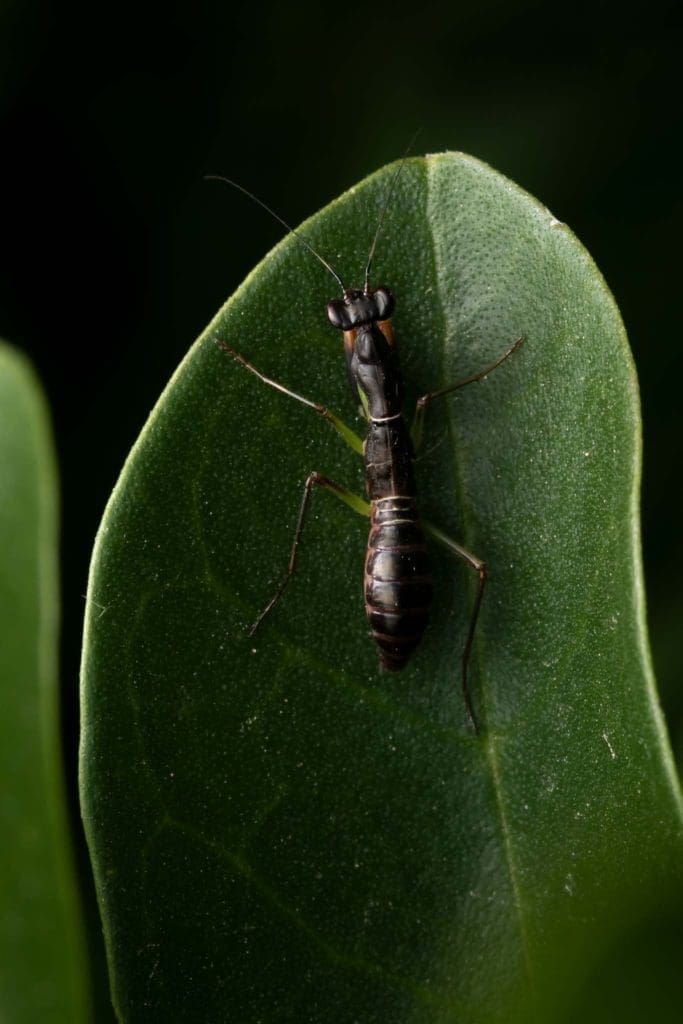
Many insects and spiders have been observed to mimic ants. This lets them blend in with ants and avoid predation. Ants are aggressive and, of course, they enjoy safety in numbers. Ants are also acidic in general and hence not the most palatable meal for predators.
Things without wings
My heart races as soon as the focus lands perfectly on the subject. I see the patterns for the first time through the camera viewfinder. But as easy as it is to spot bees or flies in their habitat, it is difficult to capture them as they are not always still. Non-fliers may be harder to find in the bushes, but they are much easier to photograph.
I find it difficult to explain why I’m so attracted to spiders. Spiders strike terror in the hearts of most humans, and I too admit to a certain mild dread brewing when in proximity to them. But this doesn’t stop me from admiring these amazing arachnids and the incredible ingenuity they possess.

From their hunting skills, to their camouflage methods, and being unmistakably adorable at times — spiders have been abundantly blessed by evolution. The most common spider seen at Kaikondrahalli Lake is the Lynx Spider from the family Oxyopidae, like this curious female in the image.

They can be found under leaves, close to flowers, ready to ambush their prey. They hunt by catching insects with their bare limbs, rather than setting up nets. On multiple occasions I have observed lynx spiders attempt to intimidate the approaching camera by raising their front limbs in an aggressive display, like this male from Kasavanahalli Lake. Males of some species from this family also possess visible ‘boxing gloves’ which are an extension of their palps.
Now you see them, now you don’t

Some species have evolved amazing cryptic camouflage, like this Two-tailed Spider from the genus Hersilia. Their bodies grow to a centimetre, excluding their legs and extended spinnerets, which give them their name. I found this individual on a tree bark. Even when you locate them once, they disappear as soon as you take your eyes off them. But not all of them are as invisible, and they love to be out in the open. The more curious ones would get your attention with ease, just like this Menemerus sp. jumping spider.
Jumpin’ Jacks (or Jills?)
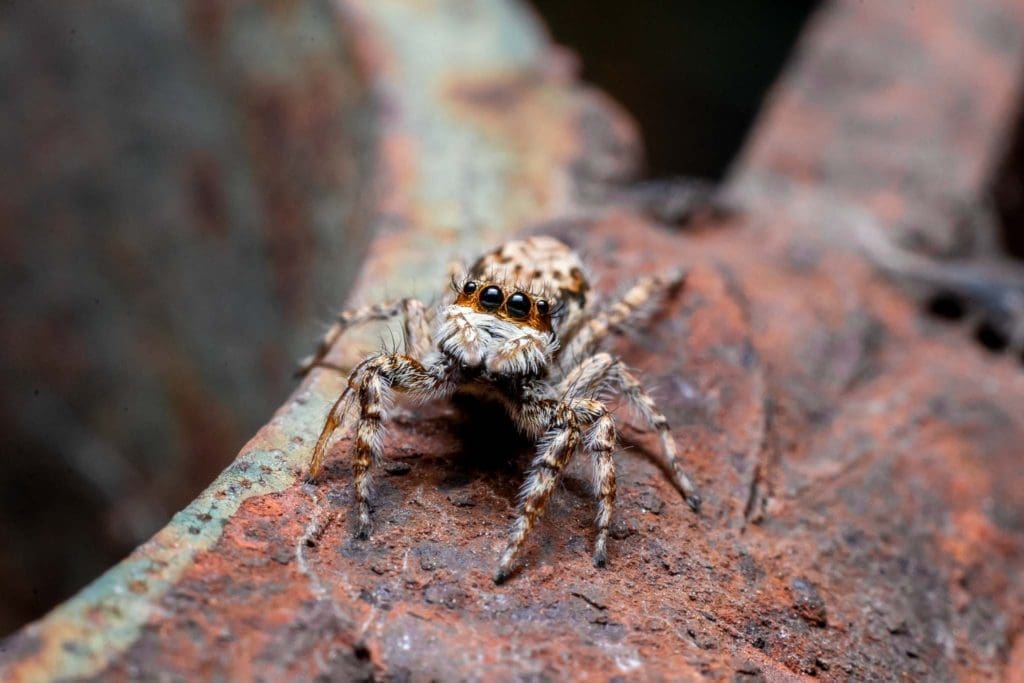
This little jumping spider, about the size of your thumbnail, was out in the open roaming about the rusted fence along the lake bund. As small as it is, its motion is unmistakable — it walks slowly but occasionally jumps from one point to another. I was trying to photograph this individual and as soon as the flash fired, it grew interested in what was happening. The first picture shows the spider looking into the flash of the camera, and you can see the light reflected in those big round eyes. In the second image, the spider lifts the palps to uncover the fangs underneath. This could have been a display of intimidation or maybe something else, but the camera got its attention nonetheless.
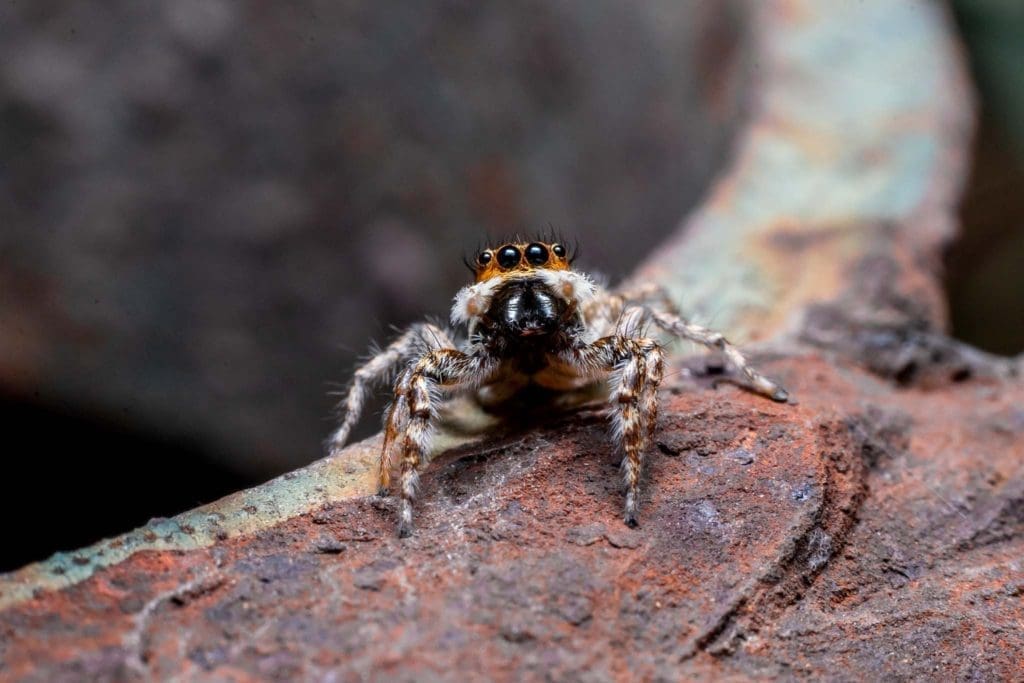
Sometimes tiny, elegant creatures sit around motionless, like this beautifully perched Eriovixia sp. on a piece of wood. My friend proceeded to pick it up, and look at how small it is against the fingernail. We left this spider in peace right after making the image.

Spiders are usually quite comfortable to deal with. I have occasionally handled spiders with caution. Sure, they are scary and intimidating at first, but having one in contact with your skin doesn’t harm you, and is a great experience. Try to give up your fear and be in contact with a spider. It’s the same with insects — beautiful insects live in hiding all among us, so keep your eyes open and take a closer look. You will never be disappointed at the majesty of these creatures.
Rhene has been my favourite genus of Jumping Spiders so far. Cute and curious, they are distinct with their first pair of forelimbs sized relatively larger than the other limbs. This one measured less than 1 cm tip-to-tip.
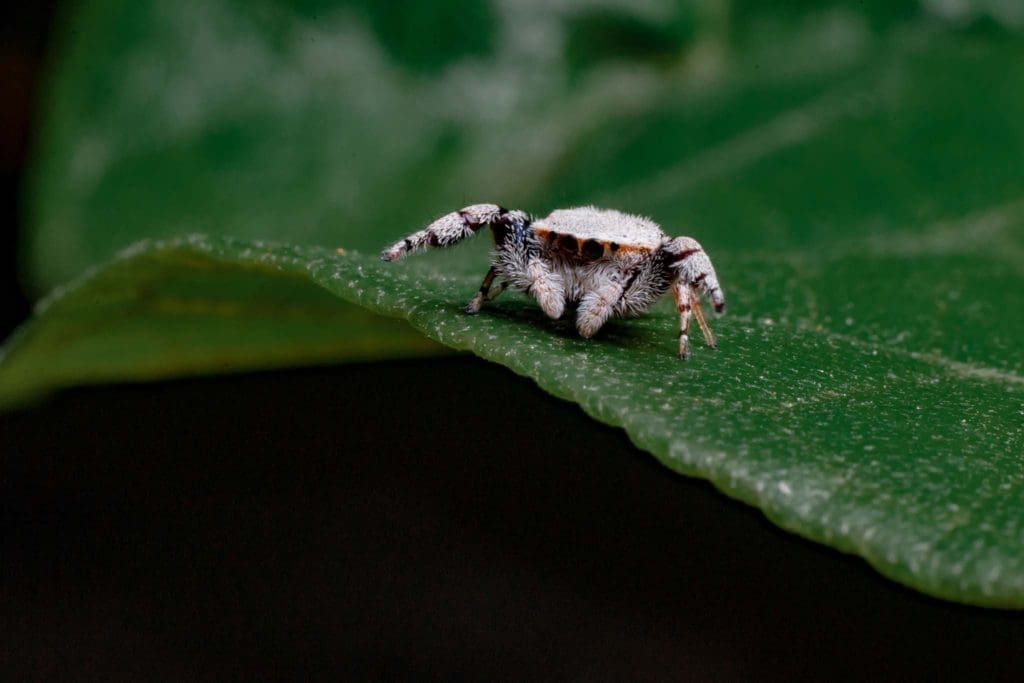
This species struck a sad chord with me a few months ago. I was looking around the lake when I stumbled upon this one. Its soft white coat mesmerised me, and the spider was genuinely curious to check out the camera. I spent a good 15 minutes observing its moves. I was captivated. Before leaving it alone, I made a note of the exact plant and its exact location where I found it. I was sure I would return to this area again as I had seen another species of Salticidae jumping spiders on the same plant that day. I had found my favourite spot at the lake.
A few months later, I returned but the plant was gone. In fact, the entire area where I had found this plant had been ‘renovated’. I don’t remember what exactly took its place — maybe a bench, maybe an extension of the jogging path, who knows. But it was disheartening to see the plant gone. I never saw this species again, and even though I saw a few more from the same genus at the lake, none made me feel the way this one did.
These small steps towards ‘development’ ultimately consume everything we love about nature. We lose bird populations in the cities every day. We lost at least half the biomass of insects globally in just three decades (according to a European and North American localized study). The dust and plastics that our machines breathe out, and we introduce into our freshwater ecosystems affect insects more than we think. When you start reading about these tiny deaths of Planet Earth everyday, you are bound to lose hope.
And we can continue to distract ourselves from these realities with streaming services, food, politics, and everything else. Or even watch natural history documentaries, which portray wild animals across the world living in a utopia, while governments and corporations strip away little by little what we have left of our natural heritage.
All things considered, this lake remains one of my favourite spots for macro photography and I find myself coming back here repeatedly in search of creatures I’ve never seen — and which are hard to see — as long as they are still around to be seen.
All photographs © Vedant Sapra



MAPSAS ‘ decade long efforts to conserve the water and bio diversity in Kasavanahalli, Kaikondrahalli, Saul Kere, Lower Ambalipura, Devarabisanahalli gets tremendous fillip when natural lovers like you share the delightful experiences in such a vivid manner. Looking forward to many more wonderful vlogs.
All the photos are exceptional. The eyes of the dragonfly and spider were beautiful. Keep it up boi!